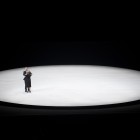Duke Bluebeard's Castle 2013Frankfurt Opera
Read more about the opera Duke Bluebeard's Castle
Britain had, so far, seen little of the work of Barrie Kosky, hailed as one of Australia's most exciting theatre and opera directors, who now works widely in Europe. The Festival showed the way, with an adaptation of L'incoronazione di Poppea at the 2007 Festival, as well as a production of Tell-Tale Heart. These were followed last year by the ENO production of Rameau's Castor et Pollux. His handling of baroque opera is stimulating, if not to all tastes. There was a lot of interest in how he would handle one of the great operas from the early twentieth century.
Robert Hayward was welcome back after his success in last year's Makropulos Case. He had not been seen in Scotland since the development of his international career, and it was good to see his dramatically subtle and beautifully sung account of the title role. Tanja Ariane Baumgartner is a rapidly rising star on the continent, though but a name here. She has several deep contralto parts in her repertoire, yet reached the higher notes of Judith's music with ease, and sang consistently with a gloriously rich tone. These two principals acted and reacted expressively, and constantly held attention.
Productions of this work invariably rely on the principals to hold our interest - the various doors so carefully described are usually left to the imagination of the audience, stimulated by Bartók's rich orchestration. This staging was no different, except for the particularly high quality of the orchestral performance under Constantinos Carydis - full-blooded, glittery and powerfully effective.
Visual variety was provided by the introduction of three extras in charcoal suits, like Bluebeard's own. Of differing ages, these clones seemed to represent earlier phases of the Duke's life, though this only became evident at the end when each briefly partnered one of the three previous wives in a (very slow) dance. Most of the time these men remained still, any significant movement being supplied by the set, an enormous disc that filled, indeed over-filled, the stage area, and revolved very, very slowly. This complex mechanism allowed this long-suffering trio to be smoked (from vents emerging between their feet), and soaked (the lake of tears drizzling onto them from the flies). Their professionalism was admirable. They were permitted to leave to get towelled off and given dry clothes in time for the final sequence where they partnered the three previous wives in a formation line up.
This stimulating staging was quite thought-provoking, and took a generally fresh approach to the work. The deawbacks came from the practicalities of the design. Handsome as the disc looked, it was so big that its edges overflowed beyond the proscenium into the backstage areas, so audience members at either side missed plenty of the action (and these seats were not described as 'restricted view', and certainly not priced as such). The absence of any vertical surfaces (we just saw the bare walls of the backstage structure) also meant that voices occasionally rose up into the flies instead of projecting into the auditorium. And the size, and immoveability of the structure (in that it had to be set up before the evening started) placed restrictions on the staging of Dido and Aeneas that took up the first half.
However, the event will surely be remembered, as good performances of Bluebeard invariably are, for a great orchestra and two singers at the top of their game.
Performance Cast
- Duke Bluebeard
- Judith Bluebeard's new wife

